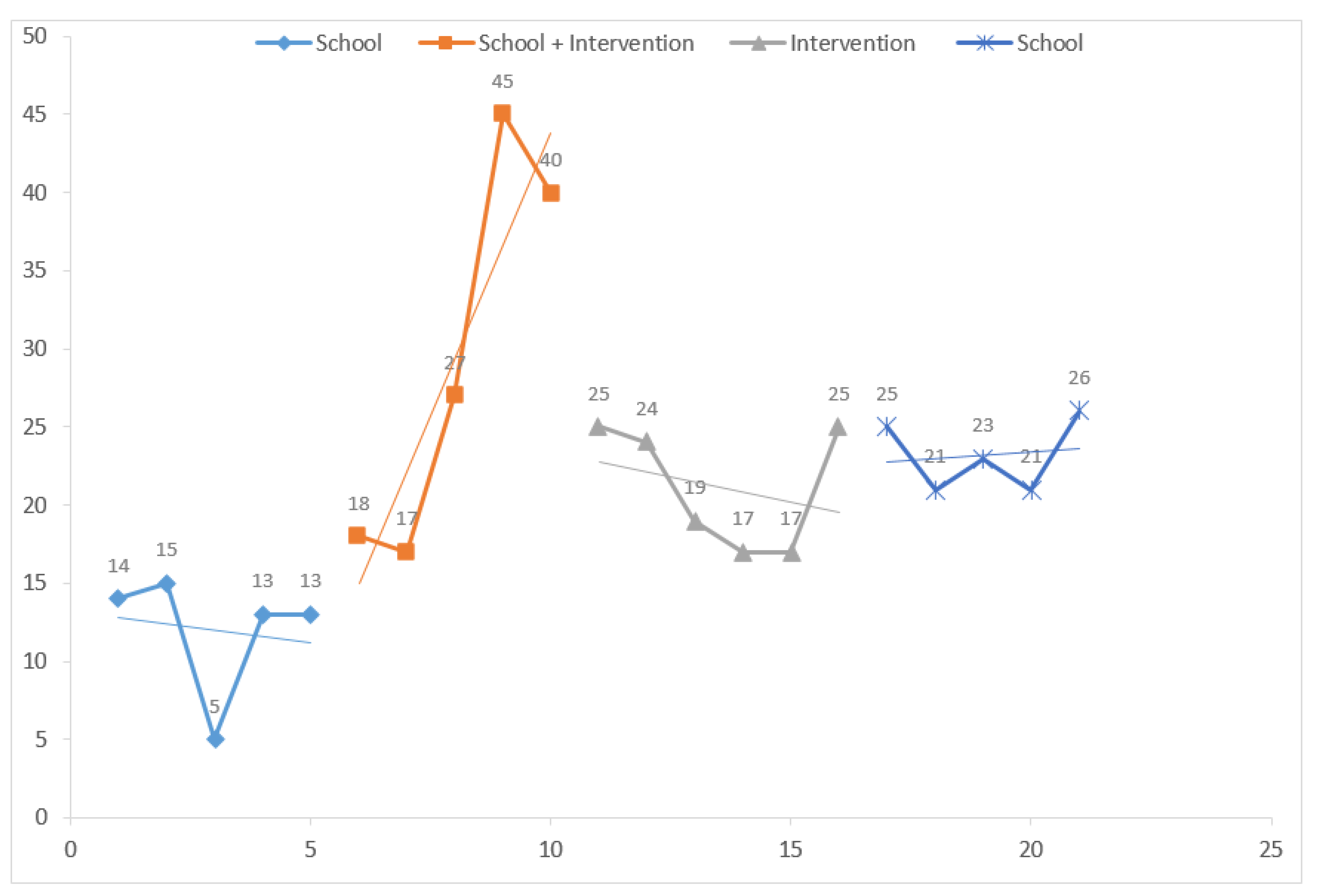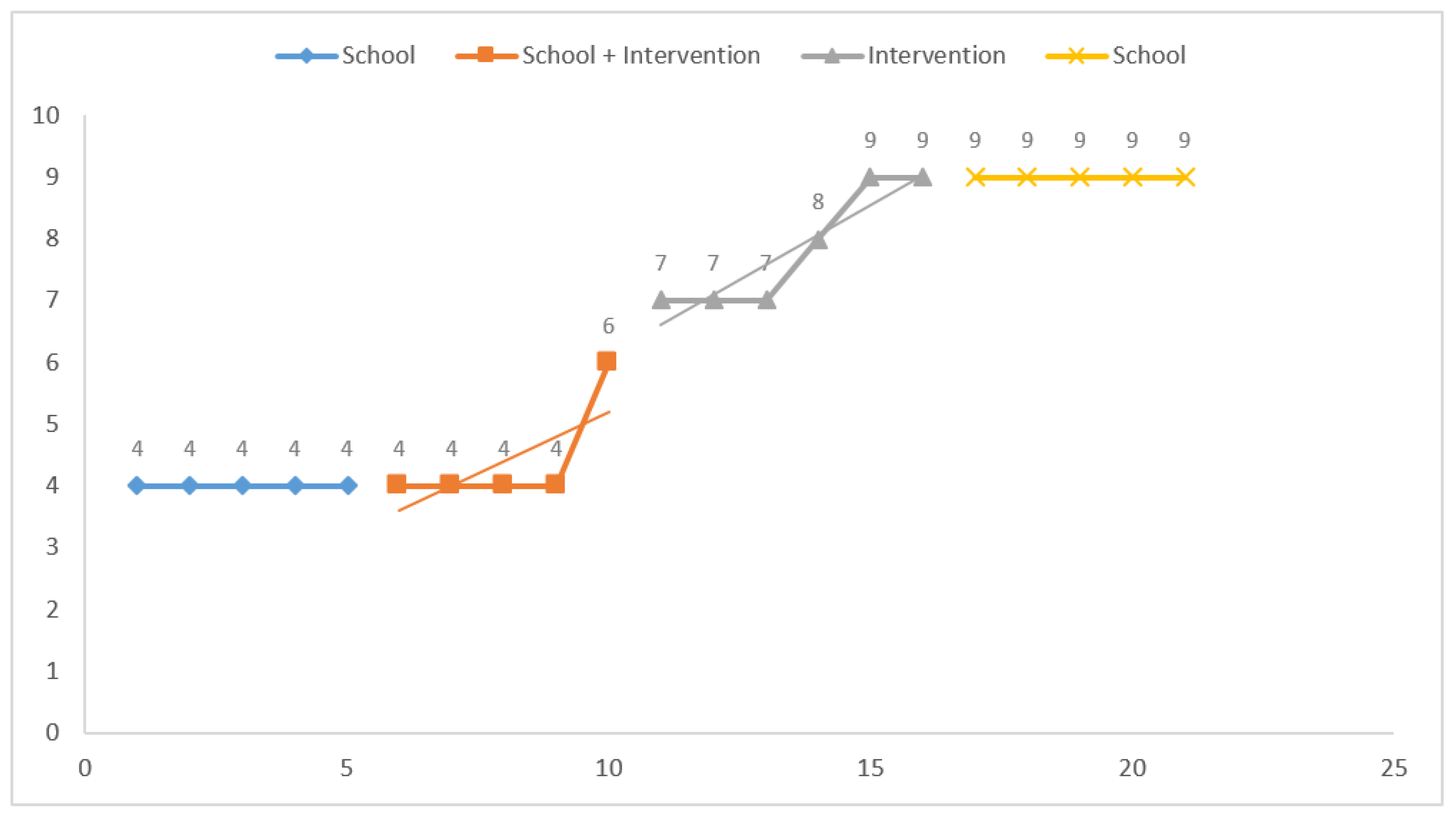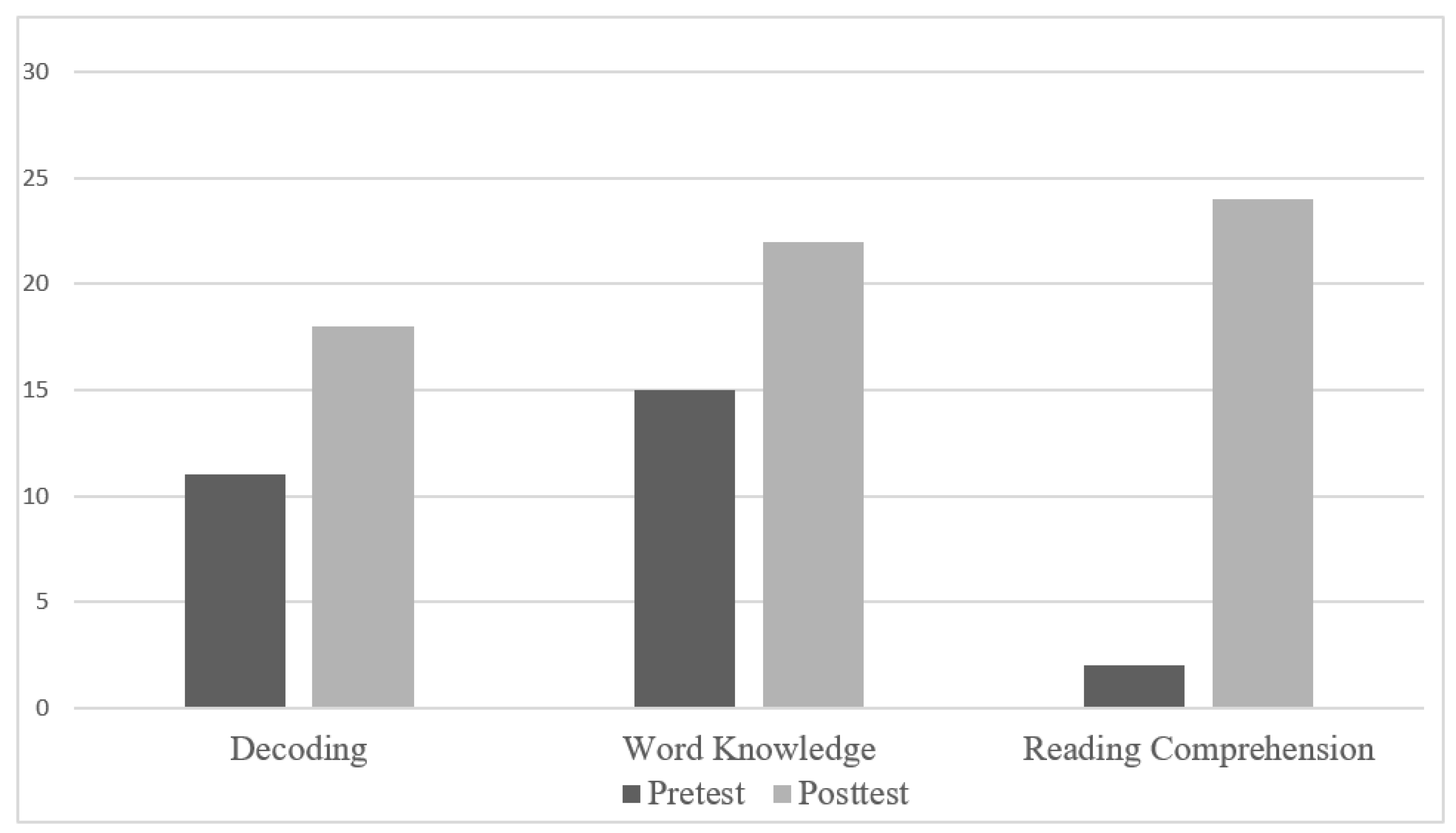Read Like Me: An Intervention for Struggling Readers
Abstract
1. Read Like Me: An Intervention for Struggling Readers
2. The Benefits of Reading Aloud
3. Significance of the Study
4. Method
4.1. The Participant and the Interventionist
4.2. Procedures
- Choose a challenging text (approximately six months above the student’s reading level);
- Read the entire text aloud with appropriate expression while the student listens;
- Go back to the beginning and read a page or paragraph aloud together;
- Read slightly ahead of the student;
- Read with good expression that matches the meaning of the text;
- Have the student reread each page/paragraph aloud;
- Continue with subsequent page/paragraphs until the text is complete;
- Have the student read the book aloud as you did in the beginning (Read Like Me).
4.3. Design and Instrumentation
5. Results
5.1. Word Recognition Automaticity
5.2. Reading Prosody
5.3. Decoding, Word Knowledge, and Reading Comprehension
6. Discussion
7. Limitations and Further Research
8. Conclusions
Author Contributions
Funding
Acknowledgments
Conflicts of Interest
References
- LaBerge, D.; Samuels, S.J. Toward a theory of automatic information processing in reading. Cognit. Psychol. 1974, 6, 293–323. [Google Scholar] [CrossRef]
- Stanovich, K.E. The impact of automaticity theory. J. Learn. Disabil. 1987, 20, 167–168. [Google Scholar]
- Förster, N.; Kawohl, E.; Souvignier, E. Short- and long-term effects of assessment-based differentiated reading instruction in general education on reading fluency and reading comprehension. Learn. Instr. 2018, 56, 98–109. [Google Scholar] [CrossRef]
- Lee, J.; Yoon, S.Y. The Effects of Repeated Reading on Reading Fluency for Students with Reading Disabilities. J. Learn. Disabil. 2016, 50, 213–224. [Google Scholar] [CrossRef]
- Roembke, T.C.; Hazeltine, E.; Reed, D.K.; McMurray, B. Automaticity of word recognition is a unique predictor of reading fluency in middle-school students. J. Educ. Psychol. 2019, 111, 314–330. [Google Scholar] [CrossRef]
- Vadasy, P.F.; Sanders, E.A. Repeated reading intervention: Outcomes and interactions with readers’ skills and classroom instruction. J. Educ. Psychol. 2008, 100, 272–290. [Google Scholar] [CrossRef]
- Allington, R.L. What Really Matters When Working With Struggling Readers. Read. Teach. 2013, 66, 520–530. [Google Scholar] [CrossRef]
- Clay, M. Becoming Literate: The Construction of Inner Control; Heinemann: Portsmouth, NH, USA, 1991. [Google Scholar]
- Leslie, L.; Caldwell, J. Qualitative reading Inventory; Pearson Education, Inc.: New York, NY, USA, 2011. [Google Scholar]
- Fisher, D.; Frey, N. Student and Teacher Perspectives on a Close Reading Protocol. Lit. Res. Instr. 2013, 53, 25–49. [Google Scholar] [CrossRef]
- Strong, J.Z.; Amendum, S.; Smith, K.C. Supporting Elementary Students’ Reading of Difficult Texts. Read. Teach. 2018, 72, 201–212. [Google Scholar] [CrossRef]
- Young, C.; Rasinski, T.; Mohr, K.A.J. Read Two Impress: An intervention for disfluent readers. Read. Teach. 2016, 69, 633–636. [Google Scholar] [CrossRef]
- Samuels, S.J. The method of repeated readings. Read. Teach. 1979, 41, 756–760. [Google Scholar]
- Heckelman, R. A Neurological-Impress Method of Remedial-Reading Instruction. Acad. Ther. 1969, 4, 277–282. [Google Scholar] [CrossRef]
- Young, C.; Mohr, K.A.J.; Rasinski, T. Reading together: A successful reading fluency intervention. Lit. Res. Instr. 2015, 54, 67–81. [Google Scholar] [CrossRef]
- Young, C.; Pearce, D.; Gomez, J.; Christensen, R.; Pletcher, B.; Fleming, K. Examining the effects of Read Two Impress and the Neurological Impress Method. J. Educ. Res. 2018, 111, 657–665. [Google Scholar] [CrossRef]
- Young, C.; Durham, P.; Rosenbaum-Martinez, C. A Stacked Approach to Reading Intervention: Increasing 2nd- and 3rd-Graders’ Independent Reading Levels With an Intervention Program. J. Res. Child. Educ. 2018, 32, 181–189. [Google Scholar] [CrossRef]
- Vygotsky, L.V. Mind in Society; Harvard University Press: Cambridge, MA, USA, 1978. [Google Scholar]
- Gallagher, M.; Pearson, P.D. The Instruction of Reading Comprehension in Contemporary Educational Psychology; Longman: White Plains, NY, USA, 1983. [Google Scholar]
- Stanovich, K.E. Matthew Effects in Reading: Some Consequences of Individual Differences in the Acquisition of Literacy. Read. Res. Q. 1986, 21, 360–407. [Google Scholar] [CrossRef]
- Mohr, K.A.; Dixon, K.; Young, C. Effective and Efficient: Maximizing Literacy Assessment and Instruction. Theor. Models Learn. Lit. Dev. 2012, 1, 293–324. [Google Scholar]
- Heath, S.B. Ways with Words: Language, Life and Work in Communities and Classrooms; Cambridge University Press: New York, NY, USA, 1983. [Google Scholar]
- Pegg, L.A.; Bartelheim, F.J. Effects of daily read-alouds on students’ sustained silent reading. Curr. Issues Educ. 2011, 14, 1–7. [Google Scholar]
- Robbins, C.; Ehri, L.C. Reading storybooks to kindergarteners helps them learn new vocabulary words. J. Educ. Psychol. 1994, 86, 54–64. [Google Scholar] [CrossRef]
- Ulanoff, S.; Pucci, S.L. Learning Words from Books: The Effects of Read-Aloud on Second Language Vocabulary Acquisition. Biling. Res. J. 1999, 23, 409–422. [Google Scholar] [CrossRef]
- Allington, R.L.; Cunningham, P.M. Schools that Work: Where All Children Read and Write; Pearson: New York, NY, USA, 2002. [Google Scholar]
- Farrant, B.; Zubrick, S. Early vocabulary development: The importance of joint attention and parent-child book reading. First Lang. 2011, 32, 343–364. [Google Scholar] [CrossRef]
- Morrow, L.M.; Brittain, R. The nature of storybook reading in the elementary school: Current practices. In Reading Books to Children: Parents and Teachers; Erlbaum: Mahwah, NJ, USA, 2003; pp. 95–113. [Google Scholar]
- Opitz, M.; Rasinski, T. Good-Bye Round Robin; Heinemann Educational Books: Portsmouth, NH, USA, 1998. [Google Scholar]
- Kalb, G.; Van Ours, J.C. Reading to young children: A head-start in life? Econ. Educ. Rev. 2014, 40, 1–24. [Google Scholar] [CrossRef]
- Smith, J.W.; Elley, W.B. How Children Learn to Read: Insights from the New Zealand Experience; Longman: Auckland, New Zealand, 1997. [Google Scholar]
- McKenna, M.C.; Kear, D.J.; Ellsworth, R.A. Children’s attitudes toward reading: A national survey. Read. Res. Q. 1995, 30, 4934–4956. [Google Scholar] [CrossRef]
- Olufowobi, O.O.; Makinde, S.O. Aliteracy: A threat to educational development. Educ. Res. 2011, 2, 824–827. [Google Scholar]
- Massaro, D.W. Reading Aloud to Children: Benefits and Implications for Acquiring Literacy Before Schooling Begins. Am. J. Psychol. 2017, 130, 63. [Google Scholar] [CrossRef]
- Garrett, J.E. Enhancing the attitudes of children toward reading: Implications for teachers and principals. Read. Improv. 2002, 39, 21–24. [Google Scholar]
- Zolgar-Jerkovic, I.; Jenko, N.; Lipec-Stopar, M. Affective factors and reading achievement in different groups of readers. Int. J. Spec. Educ. 2018, 33, 201–211. [Google Scholar]
- Martínez, R.S.; Aricak, O.; Jewell, J. Influence of reading attitude on reading achievement: A test of the temporal-interaction model. Psychol. Sch. 2008, 45, 1010–1023. [Google Scholar] [CrossRef]
- International Literacy Association. What’s Hot in Literacy 2018 Report; International Literacy Association: Newark, DE, USA, 2018. [Google Scholar]
- Farrell, E.J. Listen, My Children, and You Shall Read. Engl. J. 1966, 55, 39. [Google Scholar] [CrossRef][Green Version]
- Good, R.H.; Kaminski, R.A.; Dill, S. (Eds.) DIBELS Oral Reading Fluency. In Dynamic Indicators of Basic Early Literacy Skills, 6th ed.; Institute for the Development of Educational Achievement: Eugene, OR, USA, 2002. [Google Scholar]
- Zutell, J.; Rasinski, T.V. Training teachers to attend to their students’ oral reading fluency. Theory Pract. 1991, 30, 211–217. [Google Scholar] [CrossRef]
- MacGinitie, W.H.; MacGinitie, R.K.; Maria, K.; Dreyer, L.G. Gates-MacGinitie Reading Tests—Technical Report (Forms S and T), 4th ed.; Riverside: Rolling Meadows, IL, USA, 2002. [Google Scholar]
- Allington, R.L.; McGill-Franzen, A.; Camilli, G.; Williams, L.; Graff, J.; Zeig, J.; Zmach, C.; Nowak, R. Addressing Summer Reading Setback Among Economically Disadvantaged Elementary Students. Read. Psychol. 2010, 31, 411–427. [Google Scholar] [CrossRef]
- Dowhower, S.L. Speaking of prosody: Fluency’s unattended bedfellow. Theory Pract. 1991, 30, 165–175. [Google Scholar] [CrossRef]
- Rasinski, T.V. Why fluency should be hot! Read. Teach. 2012, 65, 516–522. [Google Scholar] [CrossRef]
- Rasinski, T. Is What’s Hot in Reading what should be Important for Reading Instruction? Lit. Res. Instr. 2016, 55, 134–137. [Google Scholar] [CrossRef]
- Young, C.; Valadez, C.; Gandara, C. Using performance methods to enhance students’ reading fluency. J. Educ. Res. 2016, 109, 1–7. [Google Scholar] [CrossRef]
- Miller, J.; Schwanenflugel, P.J. A Longitudinal Study of the Development of Reading Prosody as a Dimension of Oral Reading Fluency in Early Elementary School Children. Read. Res. Q. 2008, 43, 336–354. [Google Scholar] [CrossRef]
- Hollingsworth, P.M. An experiment with the impress method of teaching reading. Read. Teach. 1970, 24, 112–114. [Google Scholar]
- Hollingsworth, P.M. An experimental approach to the impress method of teaching reading. Read. Teach. 1978, 31, 624–626. [Google Scholar]
- Nichols, W.D.; Rupley, W.H.; Rasinski, T. Fluency in Learning to Read for Meaning: Going Beyond Repeated Readings. Lit. Res. Instr. 2008, 48, 1–13. [Google Scholar] [CrossRef]
- Wilfong, L.G. Building Fluency, Word-Recognition Ability, and Confidence in Struggling Readers: The Poetry Academy. Read. Teach. 2008, 62, 4–13. [Google Scholar] [CrossRef]
- Tamm, L.; Denton, C.A.; Epstein, J.N.; Schatschneider, C.; Taylor, H.; Arnold, L.E.; Bukstein, O.; Anixt, J.; Koshy, A.; Newman, N.C.; et al. Comparing treatments for children with ADHD and word reading difficulties: A randomized clinical trial. J. Consult. Clin. Psychol. 2017, 85, 434–446. [Google Scholar] [CrossRef] [PubMed]
- Foorman, B.; Beyler, N.; Borradaile, K.; Coyne, M.; Denton, C.A.; Dimino, J.; Furgeson, J.; Hayes, L.; Henke, J.; Justice, L.; et al. Foundational Skills to Support Reading for Understanding in Kindergarten through 3rd Grade (NCEE 2016-4008); National Center for Education Evaluation and Regional Assistance (NCEE), Institute of Education Sciences: Washington, DC, USA, 2016. [Google Scholar]
- Rosenblatt, L.M. The Reader, the Text, the Poem: The Transactional Theory of Literacy Work; Southern Illinois University Press: Carbondale, IL, USA, 1978. [Google Scholar]
- Ransom, J.C. New Criticism literacy theory. Va. Q. Rev. 1937, 14, 1–5. [Google Scholar]



© 2020 by the authors. Licensee MDPI, Basel, Switzerland. This article is an open access article distributed under the terms and conditions of the Creative Commons Attribution (CC BY) license (http://creativecommons.org/licenses/by/4.0/).
Share and Cite
Young, C.; Lagrone, S.; McCauley, J. Read Like Me: An Intervention for Struggling Readers. Educ. Sci. 2020, 10, 57. https://doi.org/10.3390/educsci10030057
Young C, Lagrone S, McCauley J. Read Like Me: An Intervention for Struggling Readers. Education Sciences. 2020; 10(3):57. https://doi.org/10.3390/educsci10030057
Chicago/Turabian StyleYoung, Chase, Stacey Lagrone, and Joyce McCauley. 2020. "Read Like Me: An Intervention for Struggling Readers" Education Sciences 10, no. 3: 57. https://doi.org/10.3390/educsci10030057
APA StyleYoung, C., Lagrone, S., & McCauley, J. (2020). Read Like Me: An Intervention for Struggling Readers. Education Sciences, 10(3), 57. https://doi.org/10.3390/educsci10030057




